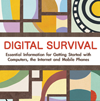- The Computer
- The Internet
- The Mobile Phone
Making the most of your mobile phone's multimedia capabilities
Photographs
A mobile phone camera can be a great way to document important events when you are in a difficult situation where a larger camera might attract unwanted attention. If all you require is small images for use in emails or on a blog or website, then the camera function on most standard mobile phones should be adequate. If you want to print your pictures, you need to think about the number of megapixels the mobile phone camera offers. If you are unsure about the capabilities of your phone's camera, it is worth testing it a few times, transferring a few trial images into the format you hope to use them in (email/print/web etc), before using the camera for anything important. Taking pictures using your mobile phone can use up its memory quickly. If you want to use your mobile phone for taking photos it is a good idea to invest in a phone that has a large memory, or one that can take external memory cards.
Sound Recording
Sound recordings are usually saved in mp3 file formats (the same as most music files). If you want to edit a sound recording, you will first need to transfer it from your phone to a computer – see Connecting to your Computer, above. The recording can be edited with a sound editing tool, such as the free software Audacity (read more about how to use this, and download it, in the Message in-a-box Hands On Guide http://messbox.tacticaltech.org/viewtool/audacity). Audacity includes many filters that can add effects to your sound recording or get rid of background noises. The process can work in the opposite direction as well: you can create recordings on your computer and transfer them to your mobile phone.
Video recording
 Video images recorded using your mobile phone will also need to be converted if you hope to edit them. Most mobile phones save video recordings in file formats called .mp4. These files can be edited using video editing software which may already be included in your Windows (Windows Movie Maker) or Mac (iMovie) operating system. For more on creating and editing videos, including links for free tools to edit and format videos see the video section of Message in-a-box http://messbox.tacticaltech.org/section/10
Video images recorded using your mobile phone will also need to be converted if you hope to edit them. Most mobile phones save video recordings in file formats called .mp4. These files can be edited using video editing software which may already be included in your Windows (Windows Movie Maker) or Mac (iMovie) operating system. For more on creating and editing videos, including links for free tools to edit and format videos see the video section of Message in-a-box http://messbox.tacticaltech.org/section/10
Sending multimedia messages
Multimedia messages allow users with MMS-capable phones to send text, photos and video to one another across a mobile network. MMS can be used to send images or videos to people, as part of a campaign, or to news sites to report on or publicise an event. Different phones compile MMS messages in different ways, but it essentially involves a similar process to email, through which pictures, video and sound files can be sent as attachments.
You should bear in mind that the cost of sending and receiving these files varies greatly between mobile phone service providers and countries. Before you start using MMS as a way of exchanging images or video, it is worth finding out the cost! The MMS function normally has to be set up by the service provider – you can find out about this by calling your provider's customer service centre.
If your intended recipient is unable to receive the MMS for some reason (perhaps the mobile phone is not MMS-enabled, or it is an older handset) then the user will receive a standard text message directing them to a website where they can view the message and attachments online.

